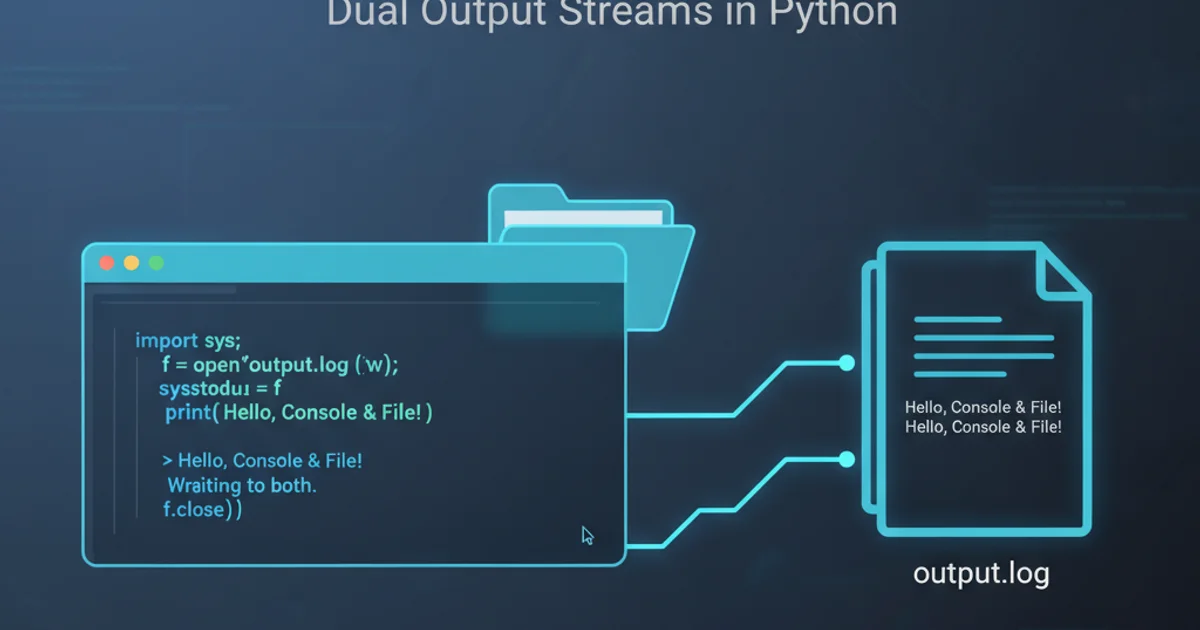How to output to the console and file?
Categories:
Mastering Console and File Output in Python

Learn how to effectively direct your Python program's output to both the console for immediate feedback and to files for persistent storage and logging.
Outputting data is a fundamental aspect of any programming language, allowing programs to communicate results, status, and errors to users or other systems. In Python, you have versatile options for directing output, primarily to the console (standard output) and to various types of files. This article will guide you through the essential techniques for both, ensuring your Python applications can effectively log, report, and store information.
Console Output with print()
The print() function is Python's built-in mechanism for sending output to the console (standard output, stdout). It's incredibly flexible, allowing you to print strings, numbers, objects, and even format them in various ways. By default, print() adds a newline character at the end, but this behavior can be modified.
print("Hello, World!")
name = "Alice"
age = 30
print("Name:", name, "Age:", age)
# Using f-strings for formatted output (Python 3.6+)
print(f"User {name} is {age} years old.")
# Changing the separator and end character
print("Item1", "Item2", "Item3", sep=" | ", end=" --\n")
print("This is on the next line after the custom end.")
Basic and formatted console output using print().
print() is invaluable. However, for structured logging in production applications, consider using Python's logging module, which offers more control over log levels, handlers, and formatting.Writing to Files
Writing data to files allows for persistent storage, enabling you to save program output, configuration settings, or data for later use. Python's built-in open() function is the gateway to file operations. It returns a file object, which then provides methods like write() and writelines().
flowchart TD
A[Start] --> B{"Open File (open())"}
B --> C{Mode?}
C -->|'w' (write, overwrite)| D[Write Data (write(), writelines())]
C -->|'a' (append)| D
C -->|'x' (exclusive creation)| D
D --> E{"Close File (close() or 'with' statement)"}
E --> F[End]Flowchart of typical file writing operations in Python.
# Method 1: Using open() and close()
file_object = open('output.txt', 'w') # 'w' for write mode (overwrites if exists)
file_object.write("This is the first line.\n")
file_object.write("This is the second line.\n")
file_object.close()
# Method 2: Using 'with' statement (recommended for automatic closing)
with open('log.txt', 'a') as f: # 'a' for append mode
f.write("Log entry 1.\n")
f.write("Log entry 2.\n")
# Writing multiple lines from a list
lines = ["Line A\n", "Line B\n", "Line C\n"]
with open('multi_line.txt', 'w') as f:
f.writelines(lines)
print("Output written to output.txt, log.txt, and multi_line.txt")
Examples of writing to files using open() and the with statement.
with statement is the safest and most Pythonic way to handle this, as it automatically closes the file even if errors occur.Redirecting Standard Output to a File
Sometimes, you might want to capture all console output from a script and redirect it to a file, without explicitly changing every print() call. Python's sys module provides a way to temporarily redirect sys.stdout to a file object.
import sys
original_stdout = sys.stdout # Store original stdout
with open('redirected_output.txt', 'w') as f:
sys.stdout = f # Redirect stdout to the file
print("This line will go into the file.")
print("So will this one.")
# Any other print() calls or functions that write to stdout
# will now write to 'redirected_output.txt'
sys.stdout = original_stdout # Restore original stdout
print("This line goes back to the console.")
Redirecting all print() output to a file using sys.stdout.
print() for its output, without needing to modify its source code.